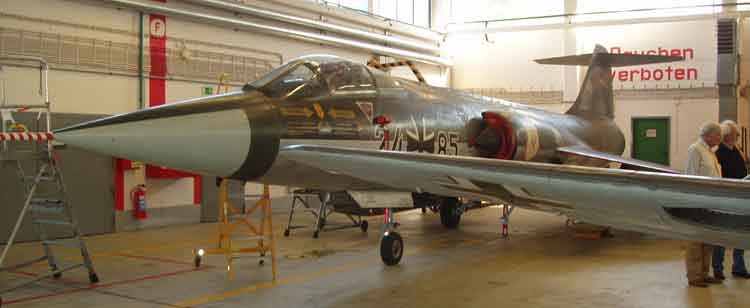
|
|
Visit May 2008 - Lockheed F-104G Starfighter in JBG-51 colours. (Thanks to Brian Walker.) Development of the F-104 was begun in 1951, when the lessons of the Korean air war were starting to bring about profound changes in combat aircraft design. A contract for two XF-104 prototypes was placed in 1953, and the first of these flew on 7 February 1954, only 11 months later. The two XF¬104s were followed by 15 YF-104s for USAF evaluation, most of these, like the prototypes, being powered by the Wright J65-W-6 turbojet. The aircraft was ordered into production as the F-104A, with deliveries to the USAF Air Defense Command beginning in January 1958. As a result of its lack of all-weather capability, the F-104A saw only limited service with Air Defense Command, equipping just two fighter squadrons. F-104As were also supplied to Nationalist China and Pakistan, and saw combat during the Indo-Pakistan conflict of 1969. The F-1O4B was a two-seat version, and the F-104C was a tactical fighter-bomber, the first of 77 examples being delivered to the 479th Tactical Fighter Wing (the only unit to use it) in October 1958. Two more two-seat Starfighters, the F-104D and F-104F, were followed by the F-104G, which was numerically the most important variant. A single-seat multi-mission aircraft based on the F-104C, the F-104G had a strengthened structure and many equipment changes, including an upwards-ejecting Lockheed C-2 seat (earlier variants had a downward-ejecting seat). The first F-104G flew on 5 October 1960 and 1,266 examples were produced up to February 1966, 977 by the European Starfighter Consortium and the remainder by Lockheed. Of these, the Luftwaffe received 750, the Italian Air Force 154, the Royal Netherlands Air Force 120 and the Belgian Air Force 99. The basically similar CF-104 was a strike-reconnaissance aircraft, 200 of which were built by Canadair for the RCAF. Canadair also built 110 more F-104Gs for delivery to the air forces of Norway, Nationalist China, Spain, Denmark, Greece and Turkey. Also similar to the F-104G was the F-104J for the Japan Air Self-Defence Force; the first one flew on 30 June 1961, and 207 were produced by Mitsubishi. The F-104S was an interceptor development of the F-104G, with provision for external stores, and was capable of Mach 2.4; 165 were licence-built in Italy. Pilots were generally fond of the F-104. The cockpit was well designed and roomy, having all the instruments and switches conveniently located and affording an excellent view. Nosewheel steering made for easy ground manoeuvring, and was used up to 185km/h (115mph) during the take-off roll. In the air the Starfighter was remarkably stable, but the stick forces were heavy. Aerobatics in the rolling plane were quite conventional, but a great deal of sky was used up in the looping plane. A loop with maximum dry power was started from 926km/h (575mph) indicated airspeed and required about 3,050m (10,000ft) of air space. Approach and landing presented no special problems. Constant speed approaches were flown, speed over the threshold being 324-380km/h (201-236mph) depending on fuel weight. The wheel brakes were very effective, brake protection being provided by an electrical generating device in each wheel, and the 5.5m (18ft) brake parachute could be used at speed of up to 380km/h (236mph). An arrester hook was installed for emergency use. Specification refers to the F-104G. Crew: 1; Powerplant: one 7,076kg (15,6001b) thrust General Electric J79-GE-11A turbojet engine, Performance: max speed 1,845km/h (1,146mph); range 1,740km (1,081 miles); service ceiling 15,240m (50,000ft); Dimensions: wingspan 6.36m (20ft 10in); length 16.66m (54ft 8in); height 4.09m (13ft 5in); Weight: 13,170kg (29,0351b) loaded; Armament: one 20mm (0.79in) General Electric M61A1 cannon; Sidewinder air-to-air missiles on wing or fuselage stations; up to 1,814kg (4,0001b) of ordnance, including Bullpup air-to-surface missiles. (Thanks to "The Encyclopedia of Aircraft" by Robert Jackson). |